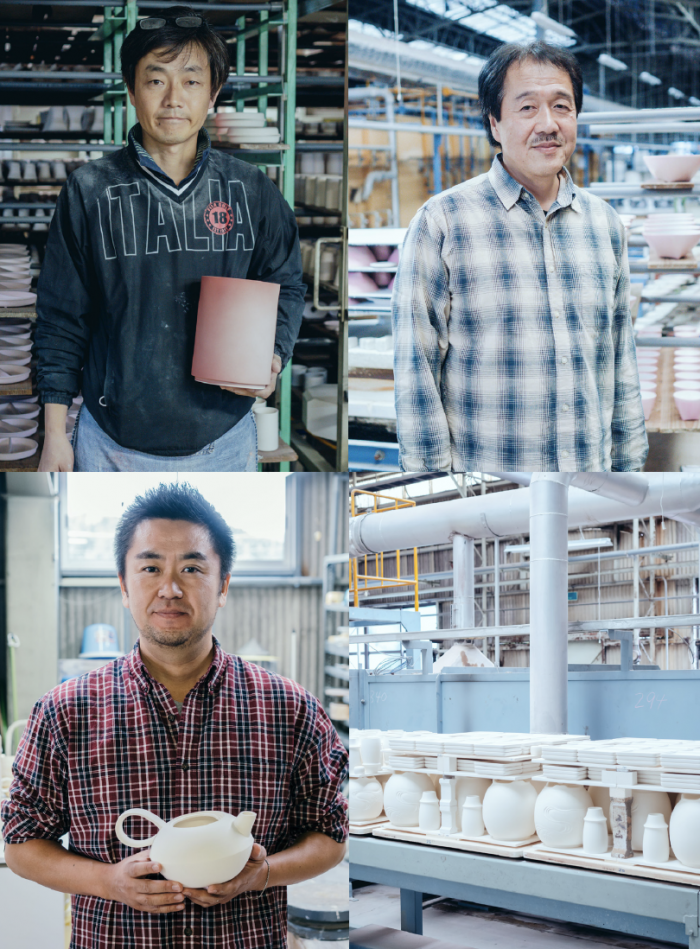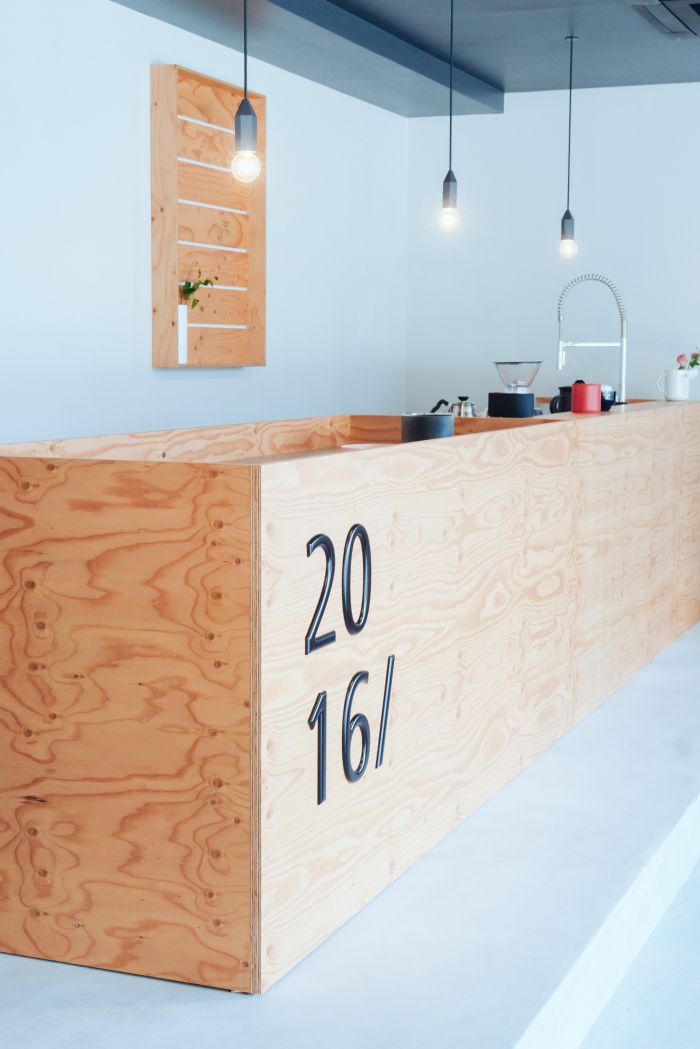A common sight in Arita, a quiet street with a traditional house.
At Tajima Shooten’s clay factory,
the perfect ratio of water and filtering creates the right substance.
A common sight in Arita, a quiet street with a traditional house.
At Tajima Shooten’s clay factory,
the perfect ratio of water and filtering creates the right substance.
Shops, factories, workshops, museums and festivals: it’s all about porcelain. You simply can’t get away from the fragile stuff when you visit the Japanese city of Arita. Up until five years ago, the local potters mainly produced traditional Kakiemon porcelain – these days they also get into contrary, innovative design. So what’s up?
Anne-Sophie Markus is enthusiastic about the subject of refined Arita porcelain: ‘Japan cherishes its crafts.’ She travelled to the porcelain city with her camera in tow, to speak with the people who still practice the ancient craft on a daily basis. ‘It really is centuries old: in 2016, the porcelain region celebrated its 400-year anniversary.’ The celebration involved the launch of an innovative design collection and the opening of the Arita residency, a workplace for Dutch artists and designers.
Moulds, the communal oven and facilities at Kouemon Ltd, shared by eight small pottery companies.
Some of these artisanal companies were involved in 2016/.
Rough materials in the warehouse at Tajima Shooten’s clay factory.
And there was the Arita House in Amsterdam, a pop-up gallery and shop, a stone’s throw away from the Rijksmuseum which was showing an exhibition on Arita porcelain at the time. By now the media circus is over, but the tranquil town of Arita is still talking about 2016/. ‘Which stands to reason, because thanks to this daring project, the métier of its inhabitants has been restored.’
The quarry lies at the edge of Arita. It was discovered in the seventeenth century and is now almost exhausted. What is left of the limestone is used exclusively for the traditional milky-white pieces. Today’s porcelain is made of limestone from the town of Kumamoto, inland on the island of Kyushu.
In the Dutch Golden Age, the Dutch East India Company saw an opportunity for profit in porcelain from Arita. That’s how the Netherlands got to know the seductive milky-white porcelain, with rich motifs in iron red, cobalt blue and gold. Especially the enameled Kakiemon porcelain was very popular. What followed is a success story that had a long run, until the late twentieth century, and made it possible for Arita and the surrounding area to live comfortably off the artisanal porcelain industry. The glory days ended with the credit crunch at the beginning of the 1990s, after which globalization, aging and the exodus from the countryside caused a lot of factories and workshops to shut down. After 20 years of hardship, only a fifth of the porcelain production is left standing.
Tajima Shooten: ‘Even though I only make the clay, I still feel responsible for the end product. If a potter works with my clay and his production fails, then chances are it’s because of the clay.’
Markus: ‘The process of grinding, washing and filtering the limestone is repeated at least three times. This used to be manual work – these days it’s partly mechanized. But still, there are no high-tech installations in the clay factory, like you might expect in such a modern country.’
Markus: ‘The first thing you notice when you look out over Arita between the rice paddies and wooded mountains of the southern Japanese island of Kyushu, is the many chimneys that tower over the city. It’s all about ceramics. In the labyrinth of streets you see factories and workshops (kilns) with mounds of clay, bisque and glazed porcelain. But what stands out is the silence. It looks as if the previously bustling area has gone completely dormant.’
Left:
The rear of traditional pottery in the old town of Arita.
Middle:
On the top shelf the Japan Palace Plate by Teruhiro Yanagihara for Momota Touen. The as of yet unfinished cups are the result of the collaboration between Kin’emon Toen Co Ltd and Shigeki Fujishiro for 2016/.
Right:
The water is pressed from the mass, resulting in fine white clay, the end product of Tajima Shooten’s clay factory.
That’s why it’s not hard to understand why Noriyuki Momota felt the urgency in 2012 to turn the tide. He is the president of Momota Touen Corporation. His solution was 1616/. It was a new brand that struck gold, because with pottery by Teruhiro Yanagihara and Scholten & Baijings it was an instant success. When Momota was asked to organize Arita’s 400th anniversary, he called on his dream team. The three designers, this time as creative directors, drew 16 national and international designers to the porcelain town, starting the contemporary label 2016/.
At Kouemon Ltd, there is a large-scale production of pottery for department stores like Muji.
A large pink metal door leads to potter Gen Harada’s workshop, on the grounds of Kouemon Ltd.
During the launch at the Salone del Mobile in Milan, people partied while the craftspeople in the porcelain region held their breath. For many potters and clay producers, this project felt like a last resort. They volunteered their material and time for 2016/ and bent over backward to try to translate the inspired designer’s unknown language and loose sketches into porcelain. To do this, they had to re-evaluate their trusted craft and travel down uncharted experimental paths. They failed and tried again, to achieve a contemporary collection that in its perfection seems to have come about effortlessly. Potter Gen Harada collaborated with designer Christian Haas for 2016/. Together they created one of the bestsellers of the collection. Harada: ‘The difficulty of this design lies in the round points that are simultaneously the feet of the bowls. It's so complex that we had to give up on the accompanying plate after seven failed attempts.’ He adds quickly: ‘Thanks to this project I learned to think out of the box.’ Markus spoke to Harada during a tour through Kouemon Ltd’s workshop where, among other things, the pottery for department store Muji is produced. Eight potters share common facilities, including a huge high-tech oven.
The huge high-tech oven stands in Kouemon Ltd’s central hall. The firing process takes 24 hours and the temperature in the oven rises up to 1250 degrees.
Each piece is separately dipped in fluid glaze by hand.
Shiro Kawazoe also works here on the anniversary collection. He comes over, smiling, holding a dainty teapot. ‘This one I made together with Stefan Diez.’ He wipes the proverbial sweat from his brow in a theatrical gesture, ‘Diez is very strict. Handmade moulds and samples were measured to the millimetre. I had never dealt with such an enormous technical challenge. Easy? No, but Diez’s drive has impressed me greatly. He showed me that perseverance is rewarding. Every day I drink with satisfaction from this teapot.’

Top left in Italia shirt:
Kouichirou Yamaguchi holding a 2016/ design by Kueng Caputo.
Top right:
Potter Gen Harada.
Bottom left:
Shiro Kawazoe holding the teapot designed by Stefan Diez.
Bottom right:
Pottery for Muji, ready to go into the oven.
Shiro Kawazoe also works here on the anniversary collection. He comes over, smiling, holding a dainty teapot. ‘This one I made together with Stefan Diez.’ He wipes the proverbial sweat from his brow in a theatrical gesture, ‘Diez is very strict. Handmade molds and samples were measured to the millimeter. I had never dealt with such an enormous technical challenge. Easy? No, but Diez’s drive has impressed me greatly. He showed me that perseverance is rewarding. Every day I drink with satisfaction from this teapot.’
These bisque 2016/ vases, by Kouemon Ltd and Pauline Deltour, are waiting for the fluid glaze. The end result is a layer of enamel (Kakiemon’s seventeenth-century glazing technique) in the authentic colours of iron red, jade and cobalt blue.
The Swiss designer duo Kueng Caputo arrived at Kinemon Kiln without a translator and proceeded to communicate with potter Kouichirou Yamaguchi through gestures. ‘They sketched their design with a marker,’ says Yamaguchi, ‘and I could tell right away that they had no experience with the precision involved in porcelain.’ Yet he met the challenge and started looking for new techniques. After half a year of failed samples, the team of opportunity finally came to a micro collection of plates, bowls and vases. When asked how this unique matte gradient finish was made, he grinned: ‘That's a trade secret.’
Kinemon Kiln, the pottery where Kouichirou Yamaguchi worked on the 2016/ collection, together with Swiss designer duo Kueng Caputo.
In the mould is the design by Christian Haas and Gen Harada. It's one of the best-selling products of the 2016/ collection.
The range of 2016/’s impact became clear to Markus when she visited Tajima Shooten’s clay factory. This company has been in the family for over a hundred years. ‘Good clay is the basis for quality porcelain. Every clay producer makes their own mixes, which remain as much of a secret as a pastry maker’s recipes.’ The 72-year-old clay maker tells us how only 18 out of 60 clay factories survived the depression. How? ‘By being creative,’ says Shooten,’ The changing market forces me to research new possibilities, to develop new materials and to enter into new collaborations. You have to be unique!’ And to further emphasize what motivates him: ‘Hundreds of years of knowledge will be lost to us if craftsmanship disappears from this place.’
Luckily Yoriko Ishizawa, 2016/’s project manager, tells us that the old clay maker and the artisanal potters needn’t worry yet: ‘The contemporary collections of 1616/ and 2016/ have caused a shift. Contemporary porcelain is already 60 percent of sales. Arita has gained a new, younger target group. Fans who have an eye for quality, craftsmanship and design.’

The 2016/ shop in Arita’s Wholesale Shopping District.
See the 2016/ collection at 2016arita.com
